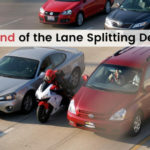We’d like to thank Steven Vance for the awesome cover photo
About Lane Splitting
Lane splitting is one of the hottest (and most controversial) topics in the motorcycle industry to date, and I’d argue that it’s also one of the most misunderstood. I’ve had trouble wrapping my head around the feeling that, while there is such an apparent lack of support for lane splitting, there isn’t much substantiation for that lack of support. The stigma surrounding this topic is thick, and thus the moral and practical ideals are largely misguided, which is why most of America can’t seem to get it right when it comes to legalization. Let’s change this.
Before I go further, I want to get a few important things out of the way. If you would like to understand more about the definition or fundamental dynamics of lane splitting, relevant US laws, and other general information on the topic, check out our articles:
Motorcycle Lane Splitting: Legality by State + Guidelines
State-by-State Guide to Motorcycle Laws (w/ Maps)
Data and Anecdote
To get anywhere, we have to find some common ground one way or another. Referring to empirical data is one of the most important tools when trying to put together a substantial, convincing argument. Don’t get me wrong; anecdote can often be valuable, but it also can be manipulated and influenced by emotion – that’s where data becomes so important. Data can be manipulated as well, but it takes much more effort, and, if the research is done with integrity, data can provide us with unbiased information and lead us to conclusions objectively. Sure, we can take turns providing our anecdote and letting our internal biases and filtering lead us through our stances — but at some point, to make progress, we will eventually have to appeal to more than that. If we aren’t willing to appeal to more than anecdote, then perhaps we just aren’t willing to have our minds changed on this topic.
Understanding Necessary Risk
Why should we be convinced that lane splitting isn’t safe? Is it because it seems scary, and there’s risk involved? Cars are scary, too, and we’ve figured out how to implement them safely and benefit. There’s a risk included in practically everything we do, and danger is undoubtedly inherent in driving. Take speed, for example, the faster we go, the more implied risk and danger. Does that mean we outlaw speed entirely? No. It means we set rules and regulations around speed, release speed warnings, and raise awareness to encourage people to drive responsibly.
Why Should We Be Convinced That Lane Splitting is Safe?
Lane splitting is a legal and widespread practice in many other countries, such as Europe and Asia. In fact, out of the European Union, Germany is the only country that restricts lane splitting to stand-still traffic. Every other country allows lane splitting in addition to the more lenient speed laws that Europe has. And the European Union also seems to be having a good outcome from their implementation of lane splitting. In 2009, the “Motorcycle Accident In-Depth Study” (MAIDS) concluded that only 0.4% of motorcycle accidents involved lane splitting. For a practice that’s mainly been considered too dangerous to implement in the US, the MAIDS study’s conclusion seems a little underwhelming in supporting that sentiment.
For argument’s sake, let’s say that European road-infrastructure and “cultural adherence” are different than in the United States, and for that reason, the above data is mostly irrelevant. Another piece of literature that has had a particularly compelling outcome was published in 2010 by Motorcycle Safety Consultant Steve Guderian. In Guderian’s report, “LANE SHARING: A GLOBAL SOLUTION FOR MOTORCYCLE SAFETY”, he compares the rear-end collision fatality rate for motorcyclists per 100,000 registered motorcycles in California against those of Florida, Texas, and Arizona – as well as with the United States national average. Keep in mind that these four states all have very similar riding demographics and riding conditions throughout the year when looking at the data.
As you can see in the figures below, California had a significantly lower rear-end collision rate than all three other states and the national average (which includes many states with lower rider volume and limited riding seasons). As Guderian states in his report, “The exception to the traffic-filtering prohibition is California, where lane-sharing is routinely practiced by a high percentage of riders in congested traffic conditions. Yet, despite significant traffic congestion and a higher number of motorcycles on the roadway, with the high number of motorcycles lane-sharing, the statistics show California has one of the lowest rates of rear-end motorcycle collisions.” The inferences of this research are that lane splitting is safe enough to implement, but, interestingly enough, that practicing lane splitting may make roads safer for everyone involved.



Why is Lane Splitting Beneficial?
Now that we’ve touched on dispelling the illusion that lane splitting is too dangerous to make work, let’s take a look at how it may be beneficial.
The University of California, Berkeley, published two separate studies (Funded by the California Office of Traffic Safety) in 2014 and 2015 on lane splitting safety in California which both had favorable outcomes. Notably, the 2015 study, “Motorcycle Lane-splitting and Safety in California” examined motorcyclists involved in traffic collisions from June 2012 through August 2013. Out of 5,969 riders studied, only 17% had been lane splitting leading up to their collision. Interestingly enough, lane-splitting motorcyclists were also injured less frequently during their collisions and had the propensity to ride more responsibly all around than non-lane splitters. Another relevant variable that the study covered was the analysis of how speed correlates to risk when lane splitting, which ultimately should be common sense; the faster you go, the more implied risk.
The inferences we can take from this research is that, similar to Guderian’s report; lane splitting can be done safely and, in-turn provide a safer commute for motorists all around. Also, the speed at which one is choosing to use when lane splitting matters — and, at higher speeds (50mph+) risk significantly rises.
What other ways can lane splitting be beneficial? Let’s shift over (no pun intended) to another consideration: Traffic. It’s no secret that even a slight shift in traffic composition from cars to motorcycles could significantly impact traffic congestion and emissions. Have you ever considered how much time we lose in traffic each day? Imagine the potential for increased productivity if only a small percentage of traffic was alleviated.
Completed in 2011, the report “Commuting by Motorcycle: Impact Analysis” was conducted by Transport & Mobility Leuven in Belgium. Their research indicates that if they were to replace just 10% of cars with motorcycles, the time spent in traffic would be cut by 40%, and total emissions reduced by 6%. A 25% shift in composition would cut congestion entirely.
Not to mention, I think we can all agree that less congestion for commutes means lower stress levels, which leads to a better quality of life. Now I don’t want to try and extrapolate these results as it’s hard to quantify the overall impact that a shift in traffic composition would have as it would vary depending on local traffic situations (Researchers did extrapolate the data to Belgium’s entire highway network and the total time savings for all vehicles was around 15,000 hours per day). We can infer from this research that the impact even a slight shift in traffic can have is profound, and progressing to more pro-motorcycling laws would incentivize this.
Common Arguments From The Opposing Side
As I stated earlier, I haven’t come across many arguments from the opposing side that has been well-substantiated. Let’s briefly address some of the more “popular” protests that I see.
“Motorists who don’t expect to be passed by a vehicle traveling between lanes can side-swipe a motorcycle or turn into its path.”
– Richard Romer, state relations manager for AAA
The above is confirmation bias. We can’t just rely on claims that confirm our preferred beliefs while dismissing evidence that is inconsistent with our claims or ignore realities that are inconvenient and resist information that challenges our worldviews. The data that we have just simply doesn’t reflect that sentiment. The data suggests that speed is the primary factor in the scale of danger when lane splitting. If the legislation passes, and lane splitting becomes legalized, it will inevitably (and rightfully) provoke a heightened awareness in drivers to the possibility of lane splitting being practiced commonly.
“The lane is the width it is because that is what has been determined safe for a full-sized vehicle to navigate. The lane needs to have some leeway on either side in case of things like debris on the road, a driver who is in the same lane, a pedestrian, etc.”
– Reddit User
We’re all welcome to interpret lane sizes however we’d like. That said, what we can’t interpret however we’d like is data. If we have data that suggests lane splitting is overall more efficient and safer for the road, then we have to either appeal to that or substantiate why that data is inaccurate. One’s personal opinion on how they view lane sizes and design is mostly irrelevant.
Conclusion
I’m not going as far as to say that there isn’t a well-substantiated argument out there for the opposing side, I just personally haven’t heard it yet. And it’s no secret that lane splitting works best within well-regulated parameters. There are always going to be people who abuse rules and operate irresponsibly with the privileges that we have — but those poor examples aren’t the majority. The majority of people who want lane splitting legalized just want a more efficient travel-system and some convenience. Open dialogue on these controversial topics can be healthy and productive – and I am personally always open to having my mind changed — even on a topic that I feel strongly about. If you feel as though there’s an argument that’s worth bringing to the table, then I would be more than happy to listen to it — and I encourage you to share it with us. Hopefully, this article will inspire people to think deeper and consider the bigger picture, not just when it comes to lane splitting but for any controversial topic. Ride safe.


